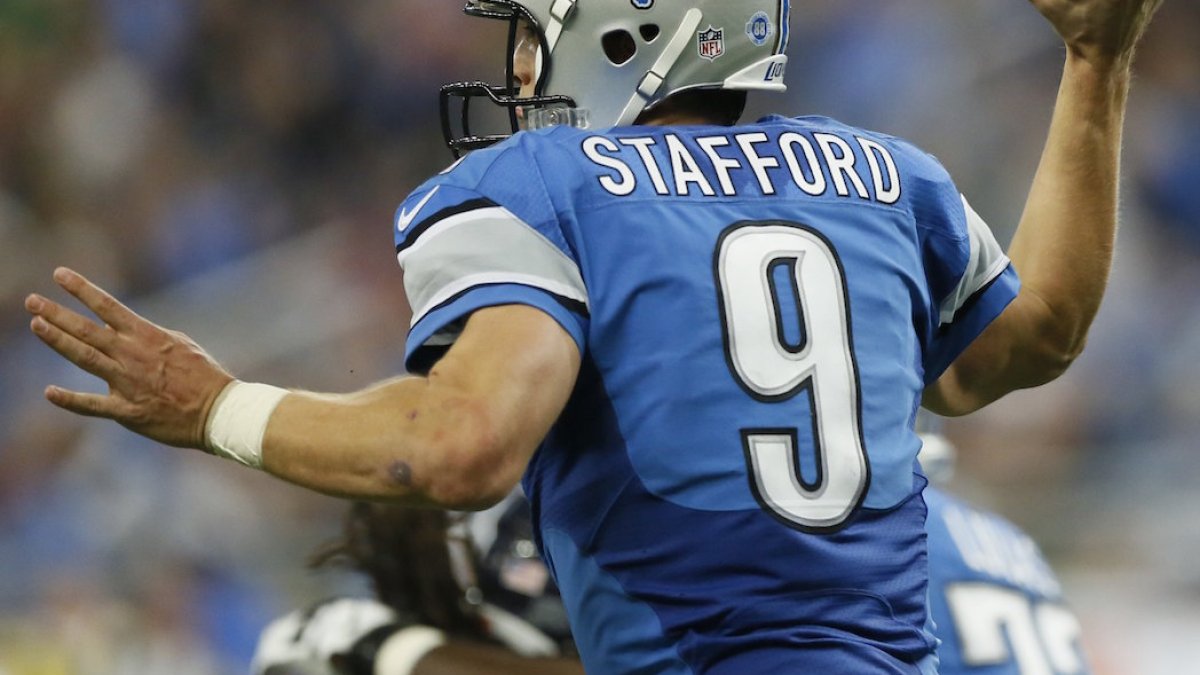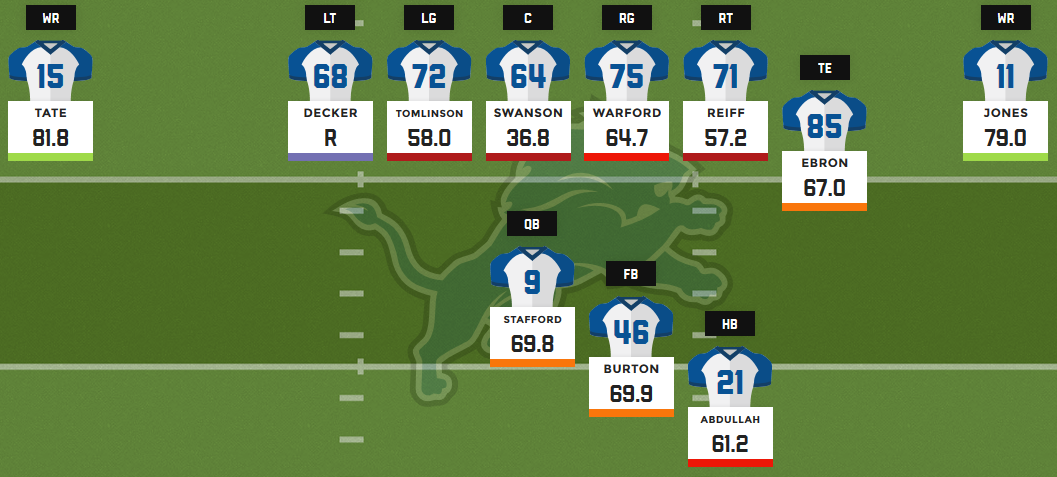(Editor’s note: As we lead up to the season, Director of PFF Fantasy Jeff Ratcliffe is breaking down each team’s depth chart from a fantasy perspective. Catch up on the work so far here.)
It was a tale of two teams last season in Detroit. The Lions spun their wheels out of the gate, looking downright bad at times. But they were reborn following their Week 9 bye and the ousting of former offensive coordinator Joe Lombardi. With Jim Bob Cooter calling the plays, Detroit went 6-2 down the stretch and looked like a completely different team.
A lot of the Lions’ late-season success can be directly tied to the play of Matthew Stafford. Over the first half of the season, Stafford graded out as the worst full-time starter in the league. In Cooter’s offense, Stafford graded out seventh among signal callers. Over the final eight weeks of the season, he threw for 2,179 yards, 19 touchdowns and just two interceptions. He also finished fifth in fantasy scoring over that stretch. Of course, this season will be Stafford’s first without Calvin Johnson on the roster. But he’s still a very interesting option for those who like to take a quarterback-by-committee approach on their fantasy rosters.
With Johnson now retired, the Lions will look to a combination of Golden Tate and offseason signee Marvin Jones to handle a bulk of the receiving duties. Let’s be clear that neither player is going to step into Johnson’s role. Tate profiles as more of a possession receiver who isn’t targeted heavily downfield. Last year, Tate posted one of the lowest average target depths in the league at just 5.8 yards. But he excelled after the catch, forcing a position-high 30 missed tackles. For fantasy purposes, Tate offers a somewhat limited ceiling in standard scoring leagues, but he gets a nice boost in PPR formats where he should be considered a WR2.
Detroit Lions projected 2016 offense with 2015 grades:
While Tate is the favorite to lead the Lions in receiving, Jones could give him a run for his money. Coming over from Cincinnati, Jones flashed serious fantasy upside in 2013, when he found the end zone 10 times and finished 20th among wide receiver in fantasy scoring. Jones is likely to see fewer targets than Tate, but he offers a higher ceiling. That being said, it’s tough to endorse Jones as more than an upside WR3 option.
Beyond Tate and Jones, the Lions currently have T.J. Jones, Corey Fuller, Jeremy Kerley and Andre Caldwell on the roster. Of that group, Jones has received the most offseason buzz and is currently penciled in as the No. 3. Stafford named Jones as a player poised for a breakout season and he was called “one of the obvious stars” of Lions OTAs. Jones is an intriguing player, but fantasy players should avoid getting too carried away with these reports. At this point, he has yet to surface on the fantasy radar.
The Lions will also look to Eric Ebron to pick up some of the receiving slack in the wake of Johnson’s retirement. Entering his third professional season, Ebron is coming off a 13th-place fantasy finish, but he faded badly down the stretch. The learning curve tends to be a bit steep at tight end, and Ebron has reportedly gotten in better shape for the 2016 season. With an increased role in the offense, Ebron is a good bet for a breakout season. He has top-10 upside at the position and can still be drafted in the later rounds.
At running back, the Lions will turn to a three-headed monster of Ameer Abdullah, Theo Riddick and either Stevan Ridley or Zach Zenner. Abdullah figures to be the lead back, but the Lions’ use of a “big” back limits Abdullah’s fantasy upside. At this time last year, Abdullah was one of the most hyped players in the league, especially after his 45-yard run in Week 1 of the preseason. That play wasn’t the sign of things to come, as Abdullah managed an abysmal 41st-place finish among running backs in fantasy scoring. While he possesses upside, it’s tough to get behind Adbullah as anything more than an RB3.
Riddick’s role in the offense is solidified as the primary receiving back. Last year, he finished second among running backs in targets with 94, but carried the ball just 43 times. That lack of early-down work makes Riddick undesirable in standard scoring, but he’s worth RB2 consideration in PPR leagues.
[With Calvin Johnson gone, can Matthew Stafford be a starting fantasy quarterback, and how late can you get him in drafts? Check out our PFF Draft Master tool and try a mock draft, complete with offensive line grades, full projections and all the PFF data.]
The third running back spot is still up for grabs with either Ridley in the lead or Zenner as the favorite, depending on your source. Ridley floundered with the Jets last season following a torn ACL in 2014. He also missed most of offseason practices with an undisclosed injury. Zenner saw minimal work last year before broken ribs and a collapsed lung landed him on injured reserve. Of the two, he offers more upside. The No. 3 back in this offense won’t see enough volume to produce viable fantasy numbers, but this is a battle this is still worth monitoring. Should Abdullah get hurt, the No. 3 back would slide into the lead role.
There’s some solid IDP value to be had on the Lions’ defense. Ziggy Ansah continues to improve as a pass rusher and is coming off a big 2015 season where he put up 14.5 sacks and finished sixth among defensive linemen in balanced scoring. He remains a strong DL1. At linebacker, DeAndre Levy was fantasy’s top linebacker in 2014, but he missed most of last year with a hip injury. The good news is that he practiced in the offseason and appears to be on track for training camp. If he proves to be fully healthy, Levy is right back in the elite fantasy linebacker discussion.



 © 2024 PFF - all rights reserved.
© 2024 PFF - all rights reserved.